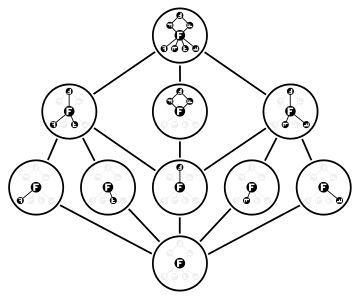Some facts
 is equal to the set of all non-generators or non-generating elements of G. A non-generating element of G is an element that can always be removed from a generating set; that is, an element a of G such that whenever X is a generating set of G containing a,
is equal to the set of all non-generators or non-generating elements of G. A non-generating element of G is an element that can always be removed from a generating set; that is, an element a of G such that whenever X is a generating set of G containing a,  is also a generating set of G.
is also a generating set of G. is always a characteristic subgroup of G; in particular, it is always a normal subgroup of G.
is always a characteristic subgroup of G; in particular, it is always a normal subgroup of G.- If G is finite, then
 is nilpotent.
is nilpotent.
- If G is a finite p-group, then
![{\displaystyle \Phi (G)=G^{p}[G,G]}](https://wikimedia.org/api/rest_v1/media/math/render/svg/0889fe5ab2e74d82eefbb7332e0abe1879d5aab8) . Thus the Frattini subgroup is the smallest (with respect to inclusion) normal subgroup N such that the quotient group
. Thus the Frattini subgroup is the smallest (with respect to inclusion) normal subgroup N such that the quotient group  is an elementary abelian group, i.e., isomorphic to a direct sum of cyclic groups of order p. Moreover, if the quotient group
is an elementary abelian group, i.e., isomorphic to a direct sum of cyclic groups of order p. Moreover, if the quotient group  (also called the Frattini quotient of G) has order
(also called the Frattini quotient of G) has order  , then k is the smallest number of generators for G (that is, the smallest cardinality of a generating set for G). In particular a finite p-group is cyclic if and only if its Frattini quotient is cyclic (of order p). A finite p-group is elementary abelian if and only if its Frattini subgroup is the trivial group,
, then k is the smallest number of generators for G (that is, the smallest cardinality of a generating set for G). In particular a finite p-group is cyclic if and only if its Frattini quotient is cyclic (of order p). A finite p-group is elementary abelian if and only if its Frattini subgroup is the trivial group,  .
.
- If H and K are finite, then
 .
.
An example of a group with nontrivial Frattini subgroup is the cyclic group G of order  , where p is prime, generated by a, say; here,
, where p is prime, generated by a, say; here,  .
.




![{\displaystyle \Phi (G)=G^{p}[G,G]}](https://wikimedia.org/api/rest_v1/media/math/render/svg/0889fe5ab2e74d82eefbb7332e0abe1879d5aab8)






